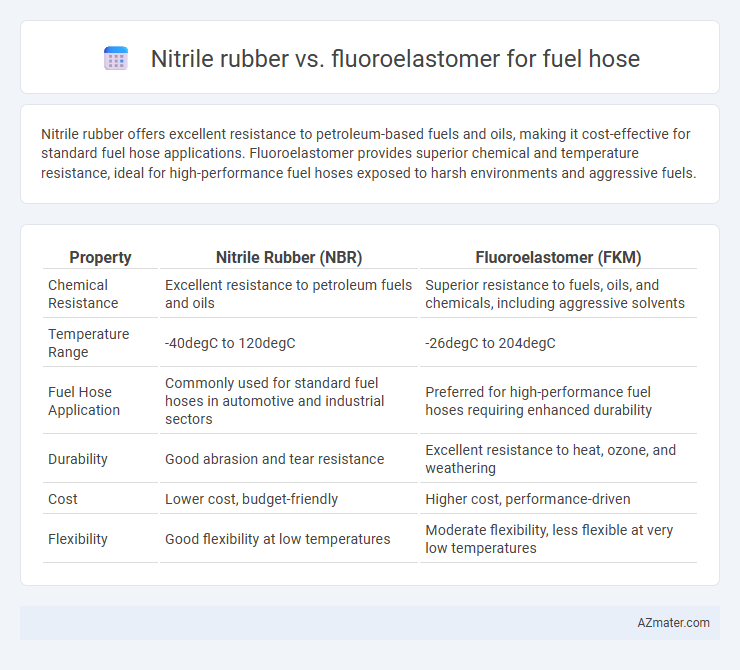Nitrile rubber offers excellent resistance to petroleum-based fuels and oils, making it cost-effective for standard fuel hose applications. Fluoroelastomer provides superior chemical and temperature resistance, ideal for high-performance fuel hoses exposed to harsh environments and aggressive fuels.
Table of Comparison
| Property | Nitrile Rubber (NBR) | Fluoroelastomer (FKM) |
|---|---|---|
| Chemical Resistance | Excellent resistance to petroleum fuels and oils | Superior resistance to fuels, oils, and chemicals, including aggressive solvents |
| Temperature Range | -40degC to 120degC | -26degC to 204degC |
| Fuel Hose Application | Commonly used for standard fuel hoses in automotive and industrial sectors | Preferred for high-performance fuel hoses requiring enhanced durability |
| Durability | Good abrasion and tear resistance | Excellent resistance to heat, ozone, and weathering |
| Cost | Lower cost, budget-friendly | Higher cost, performance-driven |
| Flexibility | Good flexibility at low temperatures | Moderate flexibility, less flexible at very low temperatures |
Introduction to Fuel Hose Materials
Nitrile rubber (NBR) and fluoroelastomer (FKM) are prominent materials used in fuel hoses due to their distinct chemical resistance and temperature tolerance. Nitrile rubber offers excellent resistance to petroleum-based fuels and oils, making it suitable for standard automotive fuel systems, while fluoroelastomer provides superior resistance to aggressive fuels, high temperatures, and ozone, ideal for demanding environments such as aerospace or high-performance vehicles. Selecting between NBR and FKM depends on specific fuel compositions, operating temperatures, and durability requirements within fuel delivery systems.
What is Nitrile Rubber?
Nitrile rubber, also known as NBR or Buna-N, is a synthetic elastomer renowned for its exceptional resistance to petroleum-based oils, fuels, and other chemicals, making it a popular choice for fuel hose applications. This material offers excellent abrasion resistance, high tensile strength, and good flexibility at low temperatures, which ensures durability under harsh operating conditions. Compared to fluoroelastomers, nitrile rubber typically provides a more cost-effective solution while maintaining reliable performance in fuel handling environments.
What is Fluoroelastomer?
Fluoroelastomer is a high-performance synthetic rubber known for its exceptional resistance to heat, chemicals, and fuels, making it ideal for fuel hose applications in demanding environments. Compared to nitrile rubber, fluoroelastomer offers superior durability and stability at elevated temperatures, along with enhanced resistance to oil and gasoline, which extends the hose lifespan. Its unique fluorine-containing polymer structure provides excellent sealing properties, reducing risks of fuel leakage and improving safety in automotive and industrial fuel systems.
Chemical Resistance Comparison
Nitrile rubber (NBR) exhibits strong resistance to hydrocarbons, oils, and fuels, making it suitable for standard gasoline and diesel applications but shows limited resistance to aromatic hydrocarbons and certain chemicals. Fluoroelastomers (FKM), such as Viton, provide superior chemical resistance against a broader range of fuels, including biofuels, synthetic oils, and aggressive chemicals like ketones and esters, ensuring enhanced durability in harsh fuel environments. For fuel hoses exposed to diverse chemical compounds, fluoroelastomers offer a longer service life and reduced degradation compared to nitrile rubber.
Temperature Tolerance Differences
Nitrile rubber (NBR) typically withstands temperatures ranging from -40degC to 120degC, making it suitable for standard fuel hose applications where moderate heat resistance is required. Fluoroelastomer (FKM), on the other hand, exhibits superior temperature tolerance, operating effectively between -26degC and 204degC, which makes it ideal for high-temperature fuel environments and harsh chemical exposure. This significant temperature tolerance difference influences the selection of material based on specific fuel system thermal demands.
Flexibility and Mechanical Strength
Nitrile rubber offers superior flexibility and excellent resistance to fuel, making it ideal for dynamic fuel hose applications requiring frequent bending. Fluoroelastomer excels in mechanical strength and chemical resistance, providing enhanced durability under high temperatures and aggressive fuel environments. Selecting between these materials depends on prioritizing either flexibility for ease of installation or mechanical strength for long-term performance in harsh conditions.
Compatibility with Fuels and Additives
Nitrile rubber offers excellent resistance to petroleum-based fuels and common additives, making it suitable for standard gasoline and diesel applications. Fluoroelastomer provides superior chemical resistance to a wider range of aggressive fuels, including alcohol blends and aviation fuels, while maintaining stability against harsh additives like detergents and antioxidants. Fuel hoses made from fluoroelastomer ensure longer service life and reduced degradation in environments with complex fuel formulations.
Durability and Longevity
Nitrile rubber (NBR) offers excellent resistance to fuels and oils, making it a durable choice for fuel hoses in standard automotive and industrial applications. Fluoroelastomer (FKM), known for superior chemical resistance and high-temperature tolerance up to 200degC, provides enhanced longevity in harsh environments such as aviation and high-performance automotive fuels. The superior thermal stability and fuel resistance of fluoroelastomers typically result in longer service life compared to nitrile rubber, especially under extreme conditions.
Cost and Availability
Nitrile rubber fuel hoses offer a cost-effective solution with widespread availability, making them suitable for standard fuel applications where budget constraints are critical. Fluoroelastomer fuel hoses provide superior chemical resistance and high-temperature performance but come at a significantly higher price and limited supplier options. Choosing between nitrile rubber and fluoroelastomer depends primarily on balancing cost efficiency against specialized fuel compatibility and durability requirements.
Choosing the Right Material for Fuel Hoses
Nitrile rubber offers excellent resistance to petroleum fuels and good durability at a lower cost, making it suitable for standard fuel hose applications with moderate temperature ranges up to 100degC. Fluoroelastomer excels in high-temperature environments, chemical resistance, and fuel permeation control, tolerating temperatures up to 200degC, ideal for demanding automotive and aerospace fuel systems. Selecting between nitrile and fluoroelastomer depends on specific fuel composition, operating temperature, and durability requirements to ensure optimal performance and longevity.

Infographic: Nitrile rubber vs Fluoroelastomer for Fuel hose
 azmater.com
azmater.com